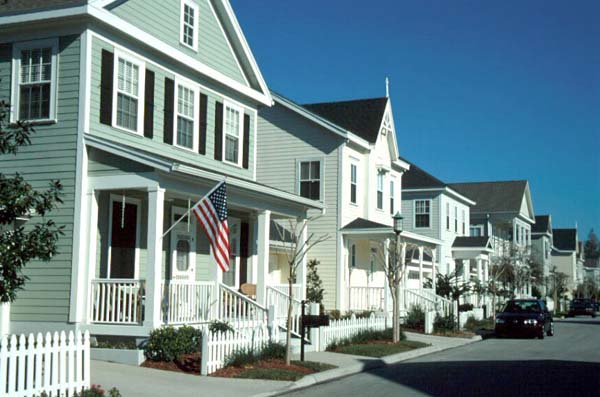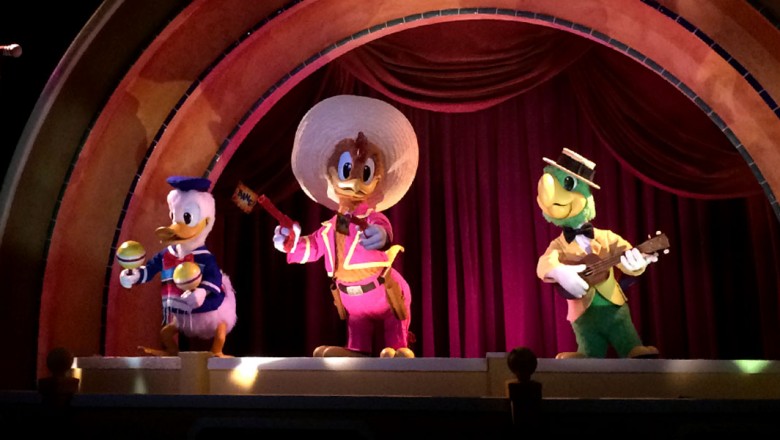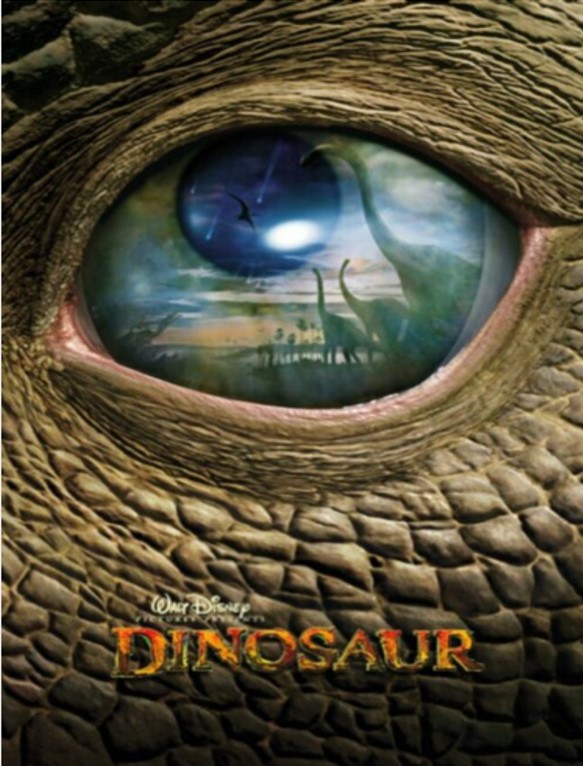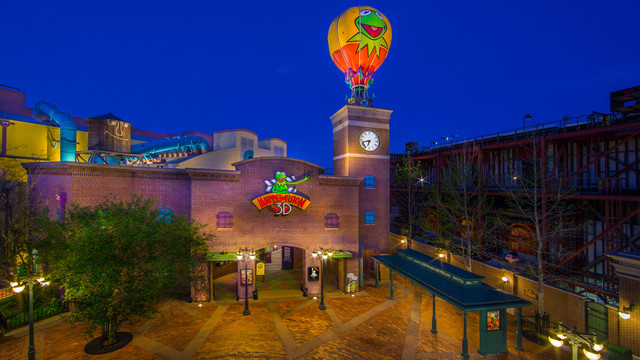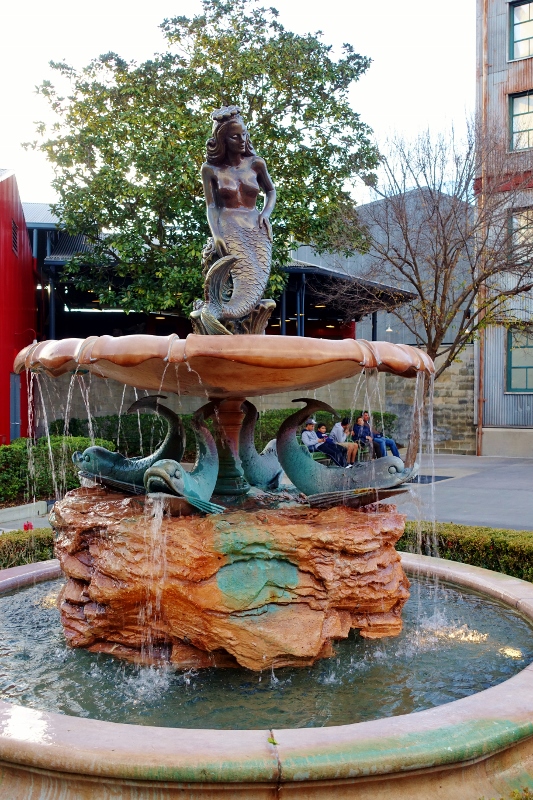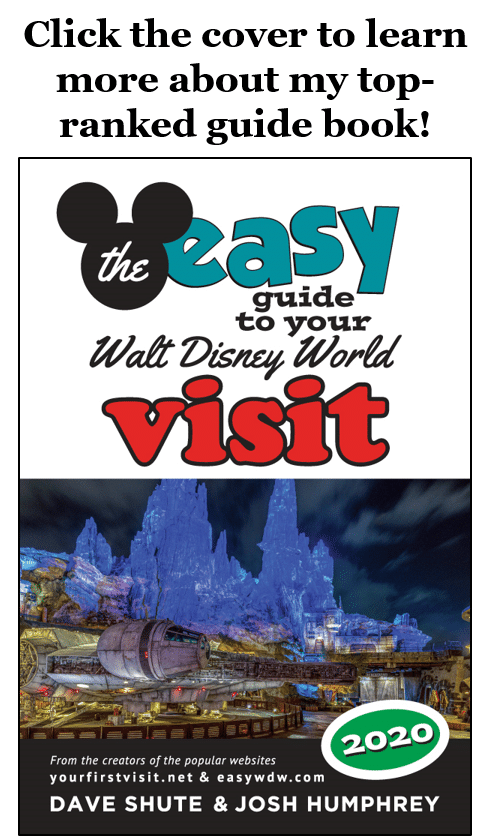Category — A Friday Visit with Jim Korkis
A Friday Visit with Jim Korkis: The Original Concepts for Celebration
Welcome back to Fridays with Jim Korkis! Jim, the dean of Disney historians and author of Jim’s Gems in The easy Guide, writes about Walt Disney World history every Friday on yourfirstvisit.net.
THE ORIGINAL PROPOSAL FOR CELEBRATION
By Jim Korkis
The first tenants of Celebration, Florida took up residence in June 1996. However, years earlier Disney had to share its plans for the area south of U.S. Highway 192.
In May 1991, Disney presented its initial proposal for Celebration to the East Central Florida Regional Planning Council for review.
Space for 20,000 residents and 15,000 employees would include 8,000 “moderately upscale” homes of all sizes and values that would be built in four themed villages between 1993 and 2015. Three of the villages would wrap around championship golf courses.
All homes would include a fiber-optic computer network that would allow homeowners to select a movie without going to a video store. Shoppers would be able to call up a recipe and get a printout of ingredients, including their location in the grocery store. The system would connect directly with the hospital so that residents could talk directly to a doctor and have things like their blood pressure monitored.
The plans included:
- Celebration Center: Two million square foot international shopping district with famous name retailers from many nations and was projected to attract ten million visitors a year. It would be designed by architect Helmut Jahn of Chicago with the first million square feet scheduled for an early 1995 opening.
- Enterprise Park: A 240,000 square foot office center designed by Italian architect Aldo Rossi. The first phase was a planned a three million square foot office park.
- Residential Community: Four villages with a variety of architectural styles. It would include 8,000 units in a pedestrian-oriented setting, twenty miles of walk and bikeways, a unique video library with a fiber-optic link to homes plus an electronically indexed grocery store.
- The Disney Institute: “A new kind of Disney learning resort to entertain, educate and revitalize guests with movies, gourmet cooking and lectures including an Entertainment Arts Academy, performing arts center and fitness spa, master-planned by AIA Gold Medal architect Charles Moore”. CEO Michael Eisner had been promoting the concept since 1984 which he described as the “cultural heart and soul of the community”.
- Medical and Health Center: Wellness services and 150 bed medical facility.
- Environmental Center: Adjoining expansive wilderness area, this unique center will teach residents and guests about the heritage of Florida wildlife and forest lands.
- Three Championship Golf Courses: Winding through Celebration villages, courses include a Signature Hole course where designers’ kiosks will provide video on each hole’s design and tips for playing it.
- Schools/Civic Areas: Schools are being planned to cater to the needs of residents , with innovative techniques and guest-teacher plan in structures which might be designed by world famous architects whose talents will be applied for the first time toward classroom design. Other civic amenities were planned.
- The Workplace: Visitors will be able to enjoy the creative ingenuity of industrial “wizards” from around the world designing and making everything from tennis balls to compact discs in facilities created to inform and entertain. Designed to promote the free enterprise system and industrial wizardry, tourists would pay to watch a product’s creation.
- Multimodal Station: A transportation facility to respond to the needs of the region and able to accommodate all forms of rail and other ground transit systems.
According to the proposal, upon completion of the Regional Impact Study review process, the property would be de-annexed from the Reedy Creek Improvement District and fall under the jurisdiction of Osceola County. Even after the de-annexation, Disney retained ownership of some assets like the downtown area and the golf course, but they were both later sold.
* * * * *
Thanks, Jim. Celebration turned out to be something quite different than this proposal, and something unique–in a lot of ways–in America.
Come back next Friday for even more from Jim Korkis!
In the meantime, check out his books, including Secret Stories of Walt Disney World: Things You Never You Never Knew, which reprints much material first written for this site, and The Vault of Walt: Volume 4, and his contributions to The easy Guide to Your First Walt Disney World Visit, all published by Theme Park Press.
Follow yourfirstvisit.net on Facebook or Google+ or Twitter or Pinterest!!
March 11, 2016 No Comments
A Friday Visit with Jim Korkis: The Three Caballeros
Welcome back to Fridays with Jim Korkis! Jim, the dean of Disney historians and author of Jim’s Gems in The easy Guide, writes about Walt Disney World history every Friday on yourfirstvisit.net.
THE RETURN OF THE THREE CABALLEROS
By Jim Korkis
The Mexico pavilion at Epcot opened in October 1982, featuring a boat ride attraction entitled El Rio del Tiempo (“The River of Time”) that took visitors through a leisurely cruise through the history of Mexico from Mayan high priests to modern merchants.
In 2007, a new storyline was developed where guests would still enjoy a boat tour experiencing the arts, culture and history of Mexico, as well as some of the famous modern day resorts and locales.
However, in the new storyline, the tour hits a snag when Panchito and Jose Carioca discover their amigo, Donald Duck, has gone sightseeing in Mexico on the very day the famous Three Caballeros are to perform a reunion concert in Mexico City.
The Three Caballeros—Donald Duck representing the United States; Jose Carioca, a parrot, from Brazil representing South America; and Panchito Pistoles, a rooster, representing Mexico—is an animated compilation feature film of the same name produced by Disney in 1944. In the film, after singing their memorable theme song, they all go on a magic serape ride over Mexico combining animation and live action.
In charge of this new revision of the ride reuniting the Three Cabelleros was director George Scribner (who was also director of Mickey’s PhilharMagic) and animation director Eric Goldberg (supervising animator on Aladdin‘s Genie and co-director on Pocahontas).
The new film elements were a combination of traditional character animation, overlaid onto film clips of live background footage that were projected onto a series of screens framed by dimensional walls, arches and rockwork to set the scenes. Throughout the attraction, props, set facades, lighting and the sound system also were refurbished and enhanced.
When this version of the Gran Fiesta Tour opened April 6, 2007, the final scene featured a large screen with animation of the Three Caballeros performing together. On December 4, 2015, this finale was replaced with three audio-animatronics figures of the three characters who had first appeared at WDW over forty-five years earlier.
The Mickey Mouse Revue was an attraction that opened at the Magic Kingdom October 1, 1971 and featured multiple small audio-animatronics figures of popular Disney cartoon characters designed and animated by Imagineer Bill Justice. These figures included the Three Caballeros singing their iconic song.
Over the years, the attraction’s popularity waned. It closed at Magic Kingdom on September 14, 1980 and was shipped to Tokyo Disneyland, where it opened April 15, 1983. It continued to operate for twenty-six years until it was replaced by Mickey’s PhilharMagic in 2009.
At that time, Epcot management made arrangements to save, purchase and have shipped to the United States three of the Three Caballeros figures from the attraction.
Unfortunately, due to a misunderstanding, there was no money left in the budget to install them in the new Gran Fiesta Tour attraction as originally intended. So for many years, they were stored safely backstage at Epcot as each year’s budget kept getting directed to other needs in the park.
The figures made their next public appearance at Disney’s Contemporary Resort as part of D23’s Destination D: Walt Disney World 40th in May 2011, when the Walt Disney Archives curated a special exhibit honoring four decades of the Vacation Kingdom and needed items that didn’t incur any costs from being shipped from the West Coast.
To celebrate the occasion of the figures being incorporated into the attraction, Disney Design Group artist Richard Terpstra working with the Walt Disney Archives as well as inspiration from the original theatrical poster for the film designed artwork for a limited edition t-shirt that was only available through December 10, 2015.
“We always thought the Three Caballeros would be perfect for the Mexico pavilion,” said Goldberg. “And it’s a great way to introduce the Disney characters to the Epcot pavilions and keep them within the context of the travel and tourism story of the World Showcase.”
* * * * *
Thanks, Jim. And come back next Friday for even more from Jim Korkis!
In the meantime, check out his books, including Secret Stories of Walt Disney World: Things You Never You Never Knew, which reprints much material first written for this site, and The Vault of Walt: Volume 4, and his contributions to The easy Guide to Your First Walt Disney World Visit, all published by Theme Park Press.
Follow yourfirstvisit.net on Facebook or Google+ or Twitter or Pinterest!!
March 4, 2016 No Comments
A Friday Visit with Jim Korkis: DINOSAUR and Lucky the Dinosaur
Welcome back to Fridays with Jim Korkis! Jim, the dean of Disney historians and author of Jim’s Gems in The easy Guide, writes about Walt Disney World history every Friday on yourfirstvisit.net.
DINOSAUR AT DISNEY’S ANIMAL KINGDOM–AND LUCKY TOO
By Jim Korkis
The Animal Kingdom attraction DINOSAUR originally opened as Countdown to Extinction in DinoLand at that park in April 1998, and is one of the few Disney theme park attractions that opened before the movie that inspired it was released.
After the movie DINOSAUR was released in May 2000, the attraction was renamed to the movie title.
The logo on the building was taken down and replaced with a sign featuring the logo for the film. The original statue at the front of the building, which was a Styracosaurus, was replaced with a statue of Aladar, the Iguanodon hero of the animated feature.
In the attraction, guests board vehicles at the Dino Institute called Time Rovers and are sent to the Cretaceous period that contains several elements from the film including the appearance of a Carnotaurus, Igaunodon and a meteor shower.
Realizing that the newly re-named attraction might attract a younger audience that had seen the movie, at the same time the movement of the vehicles was changed to be less intense and the soundtrack was revised to be less frightening so that the sound of the Carnotaurus seemed further in the distance. (Later, the attraction was amped back up to more of a thrill ride.)
Imagineer Joe Rohde, executive designer of Disney’s Animal Kingdom, and other Imagineers involved in the creation of the park, worked closely with the Walt Disney Pictures team that created the animated feature, Dinosaur to create the unique ride experience.
To publicize the film, there were even plans to have an audio-animatronics dinosaur parade walk down Main Street at Disneyland. Those readers who saw the 2012 Travel Channel special on Imagineering saw a huge box drop open and a free standing four-legged audio-animatronics dinosaur take a few steps.
Those experiments in the “Living Character Initiative” evolved into Lucky.
Lucky the dinosaur is the prototype for the next generation of audio-animatronics figures. In fact, the 20-feet long, roughly 12-feet tall, the 450-pound Lucky, who smiles, grunts, sneezes, bats his eyelashes and signs clover-shaped autographs, had very successful test runs at Disney’s California Adventure and later Disney’s Animal Kingdom.
Lucky is patterned after the Gallimimus dinosaur, but Disney designers took some liberties to soften his image so children of all ages would fall in love with him. He did vocalizations including hiccups.
Lucky was five years in development. Unlike earlier animatronics figures, Lucky is operated by electric motors and sensors that are controlled through a central computer, which regulates everything from Lucky’s ponderous footsteps to the gentle batting of his eyelashes. The batteries and computer were located in the flower cart that he pulled.
The type of skin generally used for other animatronics characters could not be used for Lucky because it was too heavy so Imagineers developed a lighter, more flexible skin.
Lucky was also meant to publicize the four hour television mini-series Dinotopia (2002) which is why Lucky’s “handler” who walked along his side was attired in garb appropriate for that show.
Lucky’s first appearance was at The Natural History Museum of Los Angeles on August 28, 2003. A few days later he visited Disney California Adventure park.
Since Lucky was only “play testing”, he returned to his home at Walt Disney Imagineering and eventually made appearances in Disney’s Animal Kingdom (May 6, 2005) at the Walt Disney World Resort and Hong Kong Disneyland Resort.
Today, he’s back home at Walt Disney Imagineering and makes occasional appearances for Adventures by Disney guests, the D23 2009 Expo and non-Disney events like the 2008 World Science Festival.
* * * * *
Thanks, Jim. And come back next Friday for even more from Jim Korkis!
In the meantime, check out his books, including Secret Stories of Walt Disney World: Things You Never You Never Knew, which reprints much material first written for this site, and The Vault of Walt: Volume 4, and his contributions to The easy Guide to Your First Walt Disney World Visit, all published by Theme Park Press.
Follow yourfirstvisit.net on Facebook or Google+ or Twitter or Pinterest!!
February 26, 2016 No Comments
A Friday Visit with Jim Korkis: Muppet*Vision 3-D
Welcome back to Fridays with Jim Korkis! Jim, the dean of Disney historians and author of Jim’s Gems in The easy Guide, writes about Walt Disney World history every Friday on yourfirstvisit.net.
THE CREATION OF MUPPET*VISION 3D AT DISNEY’S HOLLYWOOD STUDIOS
By Jim Korkis
Mark Eades is a former Imagineer who worked on Muppet*Vision 3-D. He shared these stories with me in 2010.
“Bill Prady, a Henson writer, was tasked with organizing the ideas into a story and after several meetings the first storyline came out. It was essentially an introduction to Bean Bunny and all the other Muppets had cameos.
(NOTE: Bean Bunny first appeared in 1986 as the star of the TV special The Tale of the Bunny Picnic. In 1989, Bean joined the cast of The Jim Henson Hour.)
“We all pointed out how theme park attractions based on existing characters usually worked better where there was some familiarity with their universe. Star Tours worked because it still had all those familiar Star Wars universe items in it.
“We suggested that the same thing was needed for this attraction, in particular because it had a stage and a proscenium just like in the Muppet Show—as Henson became more intrigued with breaking down that fourth wall, the ideas of having characters in the theater evolved and the story evolved.
“Jim Henson was very involved with the project. He was genuinely interested in doing theme park attractions. His natural curiosity and openness and receptiveness to new ideas made him a perfect fit to work with at Imagineering. It was a two year process from concept to finished production.
“The entire project was done in California, except for the actual installation. The film was shot almost entirely on Stage 3 at the Disney Studios, the same stage that 20,000 Leagues Under the Sea (1954) was filmed on. We needed the water tank for Miss Piggy’s musical number.
“The Miss Piggy number was the first sequence filmed. It took several days. Then we moved over to the other side of the stage for the Muppet Labs sequences, both the hallway and the Honeydew set. Then we went outside to the old Town Square from Something Wicked This Way Comes (1983) for the brick wall blowing up shot and the last shot when Kermit comes in on the fire truck ladder.
“Then we moved back to the other side of stage 3 where the Miss Piggy set was which was now black for the entire patriotic finale which was done against a black backdrop.
“The film had been completed way under budget, and after a test showing with everyone we knew we needed to tweak a few things. The middle of the film kind of fell flat. So the plan was that everyone would come back after a few weeks off and we would get together to figure it out.
“I was on vacation as a tourist in Washington D.C. with my family when the word came that Jim had died.
“We came home the next day. About a month later we got together to figure things out with the Henson creative team including Frank Oz, Bill Prady and others. We storyboarded some new scenes, including a slightly different bit about Bean Bunny running away, and scheduled a re-shoot.
“Frank Oz directed the new scenes and we did a temporary mix up at Skywalker Ranch. Another test showing and the film was signed off. Then, the Henson family asked that everyone involved from their side walk away and we had to finish the film, including all the Waldo CGI, much of which was added as a result of the new stuff, without them, including all the performers.
“It was an example of the kinds of attractions Disney could and should be doing. We at Imagineering and Theme Park Productions were extremely proud of it.”
* * * * *
Thanks, Jim. The location of Muppet*Vision 3D in the park makes me wonder if the Star Wars plans for Hollywood Studios mean it will be going away…
Come back next Friday for even more from Jim Korkis!
In the meantime, check out his books, including Secret Stories of Walt Disney World: Things You Never You Never Knew, which reprints much material first written for this site, and The Vault of Walt: Volume 4, and his contributions to The easy Guide to Your First Walt Disney World Visit, all published by Theme Park Press.
Follow yourfirstvisit.net on Facebook or Google+ or Twitter or Pinterest!!
February 12, 2016 No Comments
A Friday Visit with Jim Korkis: The Madison Mermaid Statue at Disney’s Hollywood Studios
Welcome back to Fridays with Jim Korkis! Jim, the dean of Disney historians and author of Jim’s Gems in The easy Guide, writes about Walt Disney World history every Friday on yourfirstvisit.net.
THE MERMAID FOUNTAIN AT DISNEY’S HOLLYWOOD STUDIOS
By Jim Korkis
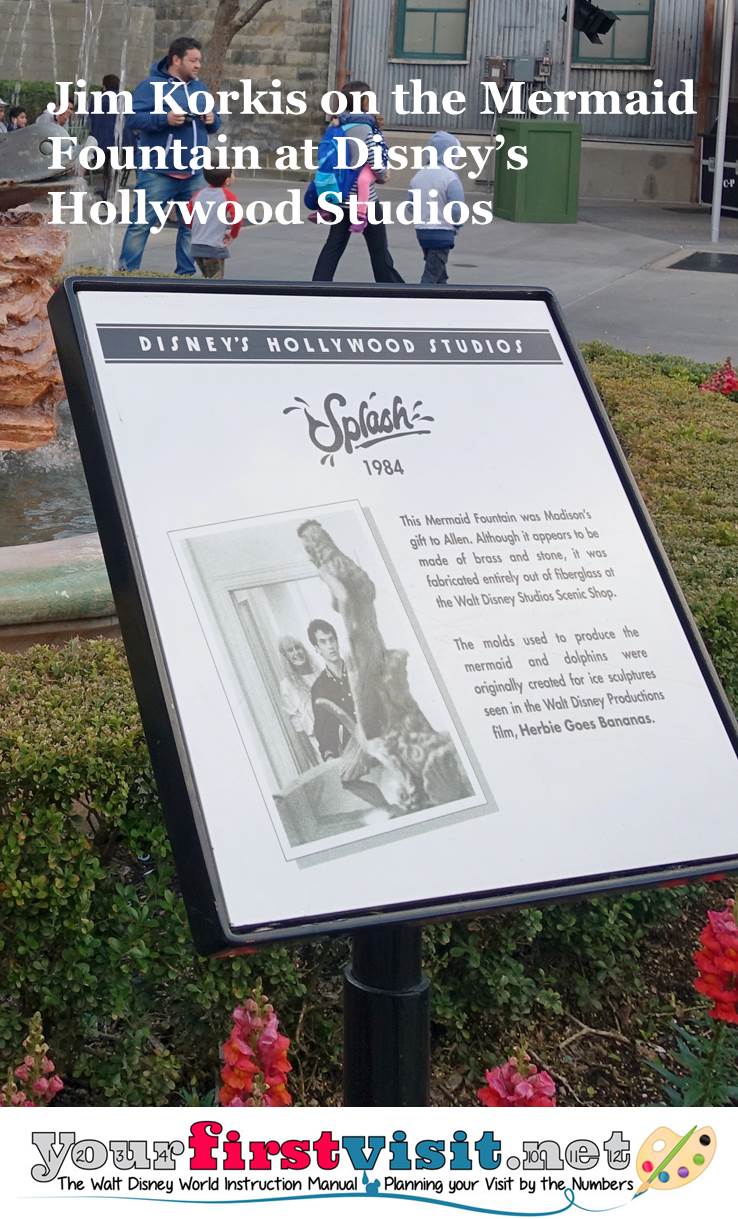
It depicts a classic demure mermaid sitting in a curved platform supported by four dolphins who are spouting water. The fountain is a prop from the film Splash.
Splash may not seem a significant enough film to be enshrined at Disney Hollywood Studios but it was the first film made by the new Touchstone division of Disney films that was created for films that might have content not appropriate for a general Disney audience.
The film was a huge financial success. Made on a budget of eight million dollars, it grossed over six million dollars on just its opening weekend and went on to be the tenth highest grossing film of the year.
Directed by Ron Howard, the film recounts the story of Allen Bauer (Tom Hanks, in the first film where he received top billing) and his encounter with a mermaid named Madison (Daryl Hannah), and how it changed his life.
The beach where Tom Hanks encounters the mermaid was filmed at Castaway Cay (then known as Gorda Cay). According to legend, Ariel in The Little Mermaid was originally going to be blonde but was made a redhead to distinguish her from the blonde Madison.
The plaque states:
“SPLASH 1984.
“This mermaid was Madison’s gift to Allen. Although it appears to be made of brass and stone, it was fabricated entirely out of fiberglass at the Walt Disney Studios Scenic Shop.
“The molds used to produce the mermaid and dolphins were originally created for ice sculptures seen in the Walt Disney Productions’ film Herbie Goes Bananas.”
(Herbie Goes Bananas was released in 1980.)
Splash was a favorite film of then CEO Michael Eisner and he green-lit a sequel called Splash Too with an entirely new cast and filmed for roughly three million dollars. It was the very first film to be completely filmed at the new Disney MGM Studios and was released in 1988.
“Because of the urgency Michael Eisner has placed on Splash Too, I’ll limit myself to co-producing it with Brian Glazer,” Howard told Marilyn Beck of the Chicago Tribune newspaper on February 28, 1985. “It will not be a copy-cat sequel. They`ll come back to land, but there will still be plenty of underwater action.”
Eisner hoped the sequel would spin off into a popular television series which is another reason for the statue to be featured so prominently at the theme park. Unfortunately, the sequel didn’t have the same impact critically or financially as the original.
Besides putting the statue in the park, Eisner intended that in 1989 at the now-gone Pleasure Island there would be a sunken bar nightclub called Madison’s Dive filled with sailors telling tall fish tales including about an elusive mermaid who would occasionally swim by one of the windows below sea level.
Some of the effects including the sinking ship in the bottle were later incorporated into the (now gone) Adventurer’s Club. Madison’s Dive would have been built on a pier that jutted out into Lake Buena Vista between the Adventurer’s Club and the XZFR Rockin’ Rollerdrome.
The Hollywood Studios Splash fountain was damaged in 2004 when Hurricane Charley broke off the mermaid but it was repaired and remains on display.
* * * * *
Thanks, Jim.
Come back next Friday for even more from Jim Korkis!
In the meantime, check out his books, including Secret Stories of Walt Disney World: Things You Never You Never Knew, which reprints much material first written for this site, and The Vault of Walt: Volume 4, and his contributions to The easy Guide to Your First Walt Disney World Visit, all published by Theme Park Press.
Follow yourfirstvisit.net on Facebook or Google+ or Twitter or Pinterest!!
February 5, 2016 No Comments
A Friday Visit with Jim Korkis: The Brown Derby
Welcome back to Fridays with Jim Korkis! Jim, the dean of Disney historians and author of Jim’s Gems in The easy Guide, writes about Walt Disney World history every Friday on yourfirstvisit.net.
THE BROWN DERBY AT DISNEY’S HOLLYWOOD STUDIOS
By Jim Korkis
There were four Brown Derby restaurants in the Los Angeles area (Hollywood, Beverly Hills, Los Feliz, and Wilshire Boulevard), but only the first one on Wilshire Boulevard was in the shape of a derby hat.
The one most frequented by Walt Disney was the restaurant on Vine Street, a half block south of Hollywood Boulevard, that opened in 1929 and was operated by his friend Bob Cobb who took over in 1934. There is a photo of a smiling Walt and his wife Lillian enjoying a Cobb salad from 1939.
The restaurant was in the center of broadcasting studios, theaters, and movie studios, so it became a popular location for celebrities and for making deals which is why the booths were designed so that people could be easily seen.
The architect was Carl Jules Weyl who later became a Warner Brothers Studio art director. He designed the iconic Rick’s Café in the classic film Casablanca (1942) where Rick (Humphrey Bogart) had an apartment office above the restaurant just like the one designed for owner Bob Cobb above the Hollywood Brown Derby.
It is this version of the famous restaurant that is recreated at Disney Hollywood Studios from a licensing agreement in 1987. The original restaurant was closed in 1985 because of fire and earthquake damage and demolished in 1994. Part of the re-creation includes a private dining room known as the Bamboo Room where today guests can dine with an Imagineer.
After midnight in 1937, Bob Cobb was awakened by the pounding on the door by his friend theater entrepreneur Sid Grauman of Grauman’s Chinese Theater. The restaurant had long been closed for the night. To help sober up his friend before sending him on his way, Cobb went into the kitchen to see what leftovers he could find.
Opening the huge refrigerator, he pulled out a head of lettuce, an avocado, some romaine, watercress, tomatoes, some cold breast of chicken, a hard-boiled egg, chives, cheese, bacon and some old-fashioned French dressing.
He started chopping it up very fine to blend the disparate items together and give it some substance. Reportedly, Grauman had just had some dental work done and could not chew easily.
It did the trick and the next day, Grauman dropped by again during operating hours and ordered a “Cobb Salad”. Other patrons saw it and also ordered it and it became a sensation. Movie mogul Jack Warner often sent his personal chauffeur over to pick up a carton of the salad.
Millions of salads have been sold over the decades and it is the most popular entrée at the Disney version.
Gossip columnist Louella Parsons declared that she was going to avoid the restaurant in order to resist the fattening desserts. In the 1930s, a fad “grapefruit diet” was popular among celebrities to lose weight.
So Cobb told his chef to come up with a dessert grapefruit cake and Parsons never left. However the dessert was made with cream cheese frosting and so was actually higher in calories than the chocolate cake.
The restaurant became famous for its celebrity caricatures that decorated the walls. The earliest ones were drawn originally by Eddie Vitch beginning in 1931 in exchange for free meals. Other artists over the years included Zel, Pancho, Jack Lane (1947-1985) and Bunn.
For Disney fans, a framed photo near the restrooms shows Disney Legend Herb Ryman in 1938 doing a sketch of entertainer George Jessel. One of the caricatures in the lobby is of a mouse-eared Jimmie Dodd of the original Mickey Mouse Club television show. The brass derbies used as lampshades and other memorabilia add to the sense of authenticity of the location.
* * * * *
Thanks, Jim.
Come back next Friday for even more from Jim Korkis!
In the meantime, check out his books, including Secret Stories of Walt Disney World: Things You Never You Never Knew, which reprints much material first written for this site, and The Vault of Walt: Volume 4, and his contributions to The easy Guide to Your First Walt Disney World Visit, all published by Theme Park Press.
Follow yourfirstvisit.net on Facebook or Google+ or Twitter or Pinterest!!
January 29, 2016 No Comments

